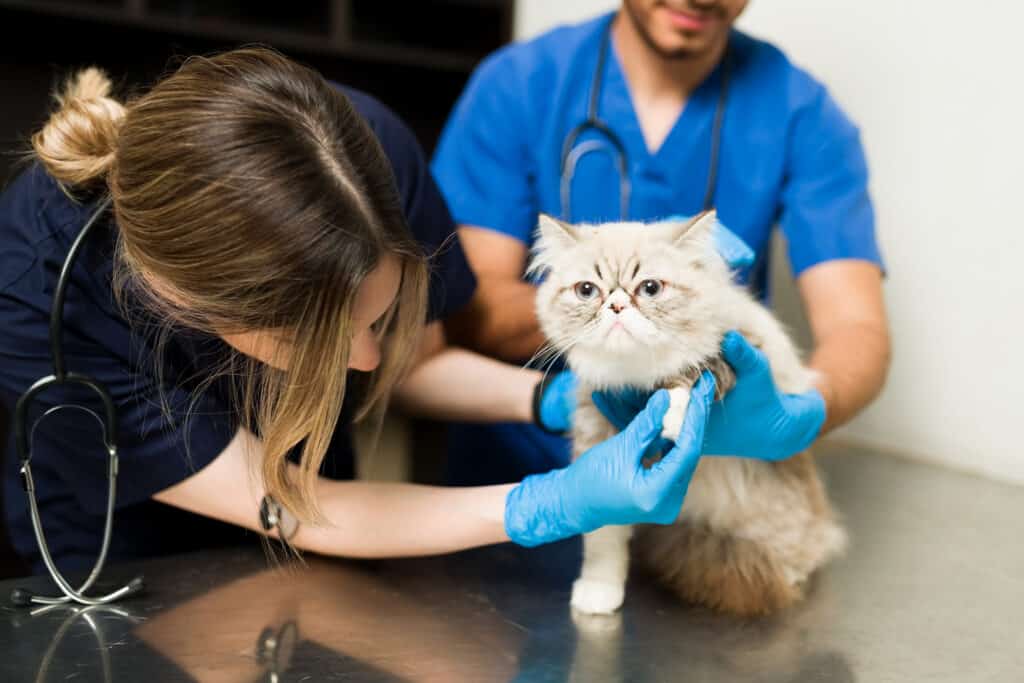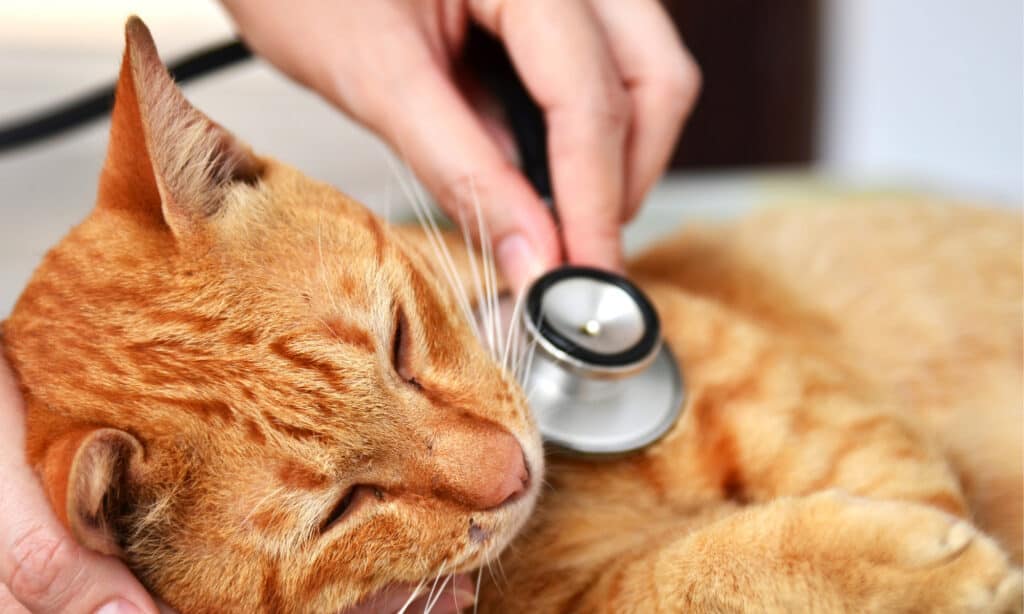If your cat is suffering from a bacterial infection, your vet might prescribe amoxicillin as a treatment. You may have some questions about amoxicillin, and how this medication may affect your cat’s health.
In this guide, we’ll discuss the amoxicillin dosage chart for the domesticated cat, possible risks, side effects, and additional questions you may have about this prescription antibiotic.
Amoxicillin for Cats: What is Amoxicillin and How Does it Work?
Amoxicillin is an antibiotic used in both human and non-human healthcare to address various bacterial infections. As a derivative of penicillin, amoxicillin belongs to the penicillin-like, class of antibiotics. Amoxicillin is also part of the beta-lactam group of antibiotics, so named for a chemical structure they contain called a beta-lactam ring. As an antibiotic in this class, amoxicillin works by inhibiting the synthesis of the peptidoglycan cell wall layer of a range of bacteria. Amoxicillin achieves this action by inhibiting penicillin-binding proteins (PBPs).
What Types of Bacteria Is Amoxicillin Effective Against?
The beta-lactam group of antibiotics that amoxicillin belongs to is currently the most broadly used of antibiotics worldwide. Amoxicillin is currently effective against a range of bacteria. The list of common pathogenic bacteria genera and species that infect cats, and that amoxicillin is effective against includes:
- Most Streptococcus species
- Some Staphylococcus species (typically in conjunction with clavulanic acid)
- Escherichia coli
- Actinomyces
- Clostridium
- Salmonella
- Corynebacteria
- Pasteurella multocida
Veterinarians frequently prescribe amoxicillin for a range of bacterial infections in cats of the skin, upper and lower respiratory tracts, gastrointestinal system, and urinary tract.

Your vet may prescribe amoxicillin for a range of bacterial infections.
©Beach Creatives/Shutterstock.com
Amoxicillin for Cats: Dosage Chart
After your vet has determined that your cat has a bacterial infection that amoxicillin is effective against, they will prescribe the appropriate dose based on your cat’s weight. The following is an amoxicillin dosage chart for cats by weight that may reflect the dose prescribed by your veterinarian. Please only give the exact amount of amoxicillin to your cat that is prescribed by your vet.
Typically, vets will prescribe amoxicillin to cats at a range of 5 mg/lb for cats up to 10 pounds. For cats above 10 pounds, the script is usually maxed out at 50mg per dose as the risk of adverse effects increases above this dose. Your vet may prescribe the medication for once or twice a day.
This chart is for cats over 6 months of age.
| Weight of Cat | Amoxicillin Dose |
|---|---|
| 5 lbs | 25 mg every 12-24 hours |
| 6 lbs | 30 mg every 12-24 hours |
| 7 lbs | 35 mg every 12-24 hours |
| 8 lbs | 40 mg every 12-24 hours |
| 9 lbs | 45 mg every 12-24 hours |
| 10 lbs | 50 mg every 12-24 hours |
| 15 lbs | 50 mg every 12-24 hours |
| 20 lbs | 50 mg every 12-24 hours |
| 25 lbs | 50 mg every 12-24 hours |
Amoxicillin for Cats: Risks and Side Effects
Generally, human and non-human doctors consider amoxicillin to be a reasonably safe and widely effective antibiotic. However, there are some risks and side effects that you should know about if your vet has prescribed this medication for your cat.
Most Common Side Effects
If your cat does experience side effects from taking amoxicillin, it’s likely that these effects will be on the mild side. The most common side effects involve the GI system and include a lack of appetite, vomiting, and diarrhea.
Allergic Reaction
Although a serious allergic reaction to amoxicillin in cats is rare, it’s always best to pay extra attention to how your feline companion is doing after administering medication. This is especially true for the first few doses. Signs of an allergic reaction to amoxicillin include fever, skin rashes, inflammation, respiratory distress, vomiting, facial swelling, increased heart rate, unsteadiness, disorientation, and diarrhea. Your cat will also likely appear anxious and in distress. If your cat displays signs of an allergic reaction to amoxicillin, take them to the vet immediately.

If your cat displays signs of an allergic reaction to amoxicillin, it’s imperative to immediately take them to the vet for further care.
©iStock.com/Jeng_Niamwhan
Damage from High Doses
Usually, the more serious risks of amoxicillin for cats only occur at extremely high doses. at these high doses, your cat may suffer from kidney or liver damage, the formation of crystals in the urine, and even kidney or liver failure. However, this is more of a risk of overdosing than taking the prescribed dosage. With that being said, always make sure medications are out of the reach of your pets.
Amoxicillin for Cats: Administering
Amoxicillin for cats is usually available in tablet, capsule, and liquid suspension forms. You can give the medication with or without food. Most caregivers have success with hiding the capsule or tablet in a tasty treat. You can also mix the liquid amoxicillin in with a handful of wet food.
So, if your cat experiences GI upset after giving them amoxicillin without food, try giving it to them with food for future doses. Make sure to administer the medication for the entire duration prescribed. You’ll often see improvement in your cat’s health within three days. Make sure to call your vet if a few days go by and your cat doesn’t improve or their condition worsens.

You can mix liquid amoxicillin into a small handful of wet food. Make sure to watch and ensure that your cat eats all of the medication.
©iStock.com/Lightspruch
Can I Give My Cat Human Amoxicillin?

When your kitty is sick, only give them medicine designed specifically for cats. Never give them human drugs, even over-the-counter ones.
©GCapture/Shutterstock.com
Amoxicillin is a prescription antibiotic medication that is available in both human and veterinary-specific formulations. Human amoxicillin is not appropriate for cats, even if it seems like the same drug. The dosage levels are different for each species, so giving your cat human amoxicillin could cause an overdose or other reactions.
In addition, many seemingly harmless over-the-counter medications are deadly to cats. Simple things like Tylenol (acetaminophen), Pepto Bismol, and aspirin are all toxic to cats. For this reason, you should never give your cat any over-the-counter or prescription medicine designed for humans.
The photo featured at the top of this post is © Pressmaster/Shutterstock.com
Thank you for reading! Have some feedback for us? Contact the AZ Animals editorial team.






